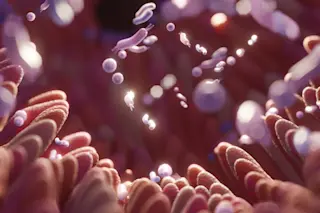Melanin is in the news these days. There's a pseudoscientific idea floating around that says that if you have lots of melanin — the pigment that colors your skin and hair and the irises of your eyes — you will be smart and exquisitely attuned to life's rhythms and have a warm, outgoing personality. In short, you will be nicer and more talented than people with less melanin — that is, white people.
Proponents of this idea, such as Leonard Jeffries, chairman of the Department of Black Studies at the City College of New York, have based their conclusions on the single scientific fact that melanin is found not only in the skin but also in the brain, and they have used the compound's presence there to imbue it with magical properties. Their "melanist" approach has gone beyond promulgation in a few pamphlets and backroom debates; it is now being taught at a number of high schools and colleges in the United States, usually as part of an effort to correct a Eurocentric view of the world. Not surprisingly, such programs have generated a great deal of criticism in the mainstream, white-dominated press — which the melanists claim is in itself an expression of racism. Why, they counter, hasn't an equal amount of disapproval been directed against the pronouncements of white biological superiority?
Two wrongs, of course, do not make a right. As a reaction and antidote to white racism, melanism is understandable. But from a scientific standpoint it is just wrong. There's no evidence for melanist claims of black superiority, just as there's no evidence for the pseudoscientific claims of white superiority that have been made for centuries. That's not to say that melanin isn't a fit subject for scientific inquiry. Indeed, just the opposite: what research has shown us is that the real story of melanin is much more interesting, and tells us more about ourselves, than any magical hokum trotted out to support divisions between the races.
We are visually oriented animals, and the color of a stranger's skin, if different from our own, is often the characteristic we notice first. Of all the superficial differences that divide us — the shape of our nose, the texture of our hair, and so on — none seems to mesmerize us as much as skin color. Our hyperawareness of it shapes our perception not only of others but of ourselves as well. As psychologists have shown, among blacks in this country, at least, the darkest-skinned children in a group or family are often treated less well than other children by their teachers, their peers, and even their parents and thus suffer repeated blows to their self-esteem. Obviously, differences in skin color matter greatly to society — but is there any physical basis for all the prejudice and psychological damage that these differences have generated?
Today geneticists like myself would say no. We have known for decades that variation in skin color is caused by rather small genetic differences, and it seems highly unlikely that these differences have anything to do with intelligence, personality, or ability. Sadly, though, genetics itself has not always been free of the taint of racism. The models that early geneticists used to explain the inheritance of skin color actually had a segregationist bias, reflecting the pervasive prejudice of their time. The white American eugenicist Charles Benedict Davenport set the tone (so to speak) in 1913 with an investigation into the genetics of "Negro-white crosses." Davenport was as racist as most of his contemporaries, and he assumed that blacks were inferior to whites. He did, however, correctly deduce that there were distinct genes that control skin color. But he thought only two genes were involved and that each of them came in two forms, or alleles: a "white" allele and a "black" allele. How dark you were was a function of how many of the four alleles you inherited from your mother and father were "black."
Davenport assumed that the black and white alleles were clearly different from each other, as the black and white races themselves, he thought, were clearly different from each other. We now know that this is not correct and that the differences between the alleles carried by the different races are small. But Davenport was right in his conclusion that a rather small number of genes make substantial contributions to skin color — more than two, it turns out, but fewer than half a dozen. And, as he noticed, skin color is inherited independently of other characteristics used to differentiate between races. Among the grandchildren of interracial marriages, he saw, there were often individuals with light skin and tightly kinked hair, and others with dark skin and straight hair. Skin color and hair texture were thus not indissolubly wedded.
Davenport knew nothing about how genes work and so had no notion of how his black alleles caused pigment to form. Only recently have studies at the molecular level shown how slight the allelic differences between races really are, and how few the steps that separate all of us from being as dark as the Bougainville Islanders of the South Pacific or as pale as Swedes.
What we have learned is that the mechanics of pigment formation are surpassingly subtle. Melanocytes, the cells that form the pigment melanin (and that occasionally run amok, giving rise to the malignant tumors known as melanomas), are closely related to nerve cells. Both types of cell arise in a part of the early embryo called the dorsal ectoderm, but while nerve cells mostly stay put to form the core of the nervous system, melanocytes migrate along with other cells to give rise to the skin. As they mature, melanocytes and nerve cells continue to share some attributes. Like nerve cells, melanocytes develop branching processes that attach to nearby cells. But whereas nerve cells use their branches to send messages, melanocytes use theirs to send packets of pigment to adjacent skin cells. A single melanocyte can color quite a large bit of the skin by pumping pigment into the cells that adjoin it.
We now know that in mice more than 50 different genes influence how melanin forms and when and where it's deposited. So it's likely that a similar number of genes will turn up in humans as well, although perhaps only half a dozen will be shown to have really substantial effects. The pigments they produce, though they're all lumped together under the melanin label, can actually be black, brown, yellow, or red. They all have a common starting point in tyrosine, an amino acid made in large amounts in the melanocytes and converted by the enzyme tyrosinase into a compound called dopaquinone. At first, biochemists thought that dopaquinone then underwent spontaneous chemical changes to form the long polymer molecules that make up melanin. But the truth was much more complex — it takes a bewildering mixture of reactions, some spontaneous and some catalyzed by enzymes, to get from dopaquinone to melanin. To cut a very long story short, dopaquinone follows two different routes, one leading to black and brown pigments, and the other to red and yellow pigments.
The master enzyme in all this is tyrosinase. If the gene for this enzyme is defective, the result is a person with albinism, someone who makes no melanin at all. But the most remarkable discovery made by molecular biologists has been that most of us, regardless of skin color, have quite enough tyrosinase in our melanocytes to make us very black. In those of us with light skin, something is preventing the enzyme from functioning at full capacity — and that seems to be a combination of two genetic mechanisms: a switch that causes the cell to make most of the tyrosinase in an inactive form, and a tendency to make a lot of inhibitors of the enzyme. In the body, the effects of either or both of these mechanisms can be modified by such environmental factors as exposure to ultraviolet light. People with albinism are highly sensitive to ultraviolet, which can easily damage skin and eyes, but most of us, regardless of which alleles we have for skin color, can protect ourselves by darkening our skin through tanning.
So it turns out that what separates blacks and whites is not different numbers of clearly different black and white alleles, but rather a collection of tiny genetic differences in the way the genes possessed by all of us are regulated — how much tyrosinase is made in an active form, how much and how many of the various tyrosinase inhibitors are made, and so on. Mutations with dramatic effect do contribute to color variation in the human population — for example, people with albinism don't make functional tyrosinase, and redheads make only small amounts — but these mutations affect only a relatively small number of people. Other mutations that lighten or darken skin color occasionally happen. Children with piebaldism, for instance, are born with a white forelock and colorless patches on their forehead and trunk. Another, more dramatic example is melasma, a skin condition that sometimes runs in families. A child with this condition is born with large patches of darker-than-normal pigmentation, which spread as the child grows older. In the late 1970s an even more unusual condition was described, in Mexico: a child was born with light skin that turned a deep, uniform black by the age of 21 months. (It is not yet known whether this condition is inherited.)
Such mutations are probably the tip of the iceberg. Richard King, a molecular geneticist at the University of Minnesota who has examined color variation in mice, suspects that much milder mutations must also happen in humans but that they tend to go unnoticed because they fall within the range of normal pigmentation. He is convinced that we are not exempt from the mutation-and-selection process that has repeatedly resulted in lighter and darker strains of animals over the course of evolution. The most famous example of such evolution is industrial melanism in moths, in which dark forms that arise by mutation are selected for in polluted areas and selected against when the pollution goes away.
In animals, melanin comes and goes at the dictates of evolutionary pressures. It is reasonable to assume, then, that we humans have this molecule not because it makes us smarter but primarily because it helps us survive a variety of environmental conditions. Clearly melanin protects us from the ravages of ultraviolet light. Some of the most darkly pigmented people in the world, natives of the North Solomon Islands, almost never get basal cell carcinoma or melanoma, and if they do have melanomas, these tumors arise on the light-skinned soles of their feet. Caucasians living in Hawaii, on the other hand, have the highest documented skin cancer rate in the United States.
But while the protective effect of having a lot of melanin is clear, it is rather less clear why many groups of humans living far from the equator have lost much of their pigment. One popular theory is based on the fact that exposure of our skin cells to ultraviolet light is necessary for the formation of a precursor of vitamin D, which in turn is required for proper bone formation. Thus, the theory goes, people who live at high latitudes — where the sun hangs low in the sky and where people are forced to keep their skin covered during much of the year — can still make enough of this precursor if they have little ultraviolet-blocking pigmentation in their skin. Conversely, the large quantities of pigment in the skins of people in the tropics should prevent them from producing too much vitamin D, which can be as harmful as too little and can cause inappropriate calcium deposits in tissues.
In evolutionary terms, of course, it makes sense that most of us have all the machinery in place to make us black or white or anything in between. Darker and lighter "races" of animals are quite common, and probably arose as a response to the dangers of predation. Dark and light Sceloporus lizards from Colorado will even move about in a laboratory setting to match themselves to the appropriate background, an instinctive attempt to protect themselves against sharp-eyed predators. My guess is that over a span of hundreds of millions of years our remote animal ancestors had to change color repeatedly, for a great variety of reasons ranging from protective camouflage to sexual attractiveness. Much of this must have taken place long before they had acquired enough brains to be prejudiced about it.
Even in Homo sapiens there are many examples of groups that have evolved toward a lighter or darker skin color than that of their close relatives. The Negritos of the islands of Luzon and Mindanao in the Philippines, for instance, superficially resemble other dark-skinned groups in Africa and Australia. Yet their overall genetic affinities turn out to be far stronger to the lighter-skinned Asian peoples who surround them. This suggests that the Negritos' ancestors may once have been lighter and that they independently evolved features that are somewhat reminiscent of black Africans, or that the Asian peoples surrounding them were also once much darker and evolved toward lighter skin — or possibly both. Another example is the Ainu of northern Japan, who have light skin but overall are very similar genetically to the darker-skinned groups that surround them. The evolution of skin color was apparently not a onetime event; it has occurred repeatedly during the history of our species.
What about neuromelanin, that other melanin, found in our brains, that Jeffries and his fellow melanists have made so much of? More skin melanin, they imply, must mean more brain melanin — which is, in some undefined fashion, good. As we have seen, melanocytes and nerve cells do have a common origin in the fetus, and indeed it's likely that nerve cells once evolved from primitive melanocytes. But this evolutionary connection does not mean that the pigment of the skin is somehow connected with the function of the brain. People with albinism, who have no melanin in their skin, hair, or eyes, have normal amounts of melanin in their brain cells. And even though the ultimate source of both types of melanin is tyrosine, the processing pathways leading to neuromelanin are quite different from those leading to skin melanin — in the brain, tyrosine is converted into dopamine, a neurotransmitter, which in turn gives rise to neuromelanin. Finally, it should be pointed out that while neuromelanin is by its very nature highly visible in brain tissues, it is only one of thousands of compounds unique to the brain and is unlikely to be freighted with mystic significance.
As for the real significance of brain melanin, the jury is still out — we have no idea what it does. We do know that a lot of it is found in the substantia nigra (the "black substance"), a darkly colored structure buried deep in the brain that makes dopamine. We also know that melanin-rich cells in the substantia nigra are the ones most likely to be destroyed in people who have Parkinson's disease, resulting in tremors and rigidity. But whether this preferential destruction is due to some property of the neuromelanin or is the result of some other process that just happens to destroy neuromelanin-rich cells is not yet clear. What is clear is that neuromelanin isn't obviously related to skin pigment, much less to a warm, outgoing personality.
Still, melanin may confer some benefits we have yet to learn about. Intriguingly, there are hints that people with lots of skin melanin are less prone to hearing damage than the more lightly pigmented among us. And as it turns out, melanin of the skin variety is indeed found in certain cells of the cochlea of the inner ear. But whether it is melanin or something else in these cells that confers the protection is unknown. Melanin has also been connected with an odd benefit of smoking. Tobacco smoke stimulates production of skin melanin, particularly in the cells lining the mouth and possibly in other tissues as well. One study has actually suggested that smokers have less noise-induced hearing loss than nonsmokers (other studies, however, have shown the reverse). The benefit, if any, is hardly enough to justify taking up the habit, though smokers will be comforted to know that if increased melanin production does protect their hearing, they may be able to go on listening to every wheeze and rattle of their abused lungs.
Clearly melanin is a handy and fascinating compound, with an intriguing evolutionary history. But because its effects are so visible in our skin, it has for centuries been made to bear an utterly undeserved burden of sociological and political significance. As is detailed elsewhere in this issue, there are far more genetic differences among the people who make up these arbitrary constructs we call races than there are differences between races. It is time to move away from simplistic efforts to explain all our differences in terms of just one molecule and to pay attention to the tens of thousands of other molecules that make up our wondrously complex cells — and selves.















